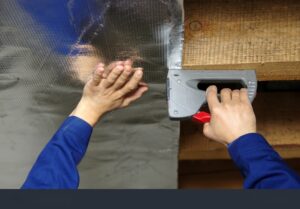
Keeping your home’s subfloor dry and sturdy can be a challenge, especially with moisture sneaking in from below. That’s where modern subfloor defense systems come into play, combining barriers and encapsulation to block out water and protect your space.
These methods work together to stop problems before they start, making your floors last longer and your home healthier. It’s a smart approach that goes beyond old-school fixes, using new techniques to keep moisture, mold, and damage at bay.
If you’re dealing with damp basements or crawlspaces, understanding how these systems work together can save you headaches and costly repairs down the road.
How Do Vapor Barriers and Encapsulation Systems Work Together Under a Home?
At first glance, vapor barriers and encapsulation systems may seem like two sides of the same coin, but they each play unique roles in managing moisture beneath a home. Understanding their collaboration is key to appreciating the next generation of subfloor defense.
- Vapor Barriers: Typically, these are heavy-duty plastic or polyethylene sheets laid directly on the crawlspace floor and sometimes up the walls. Their primary function is to block ground moisture from evaporating into the crawlspace air, which can cause humidity and condensation problems.
- Encapsulation Systems: Encapsulation takes things a step further by sealing the entire crawlspace or subfloor area, including floors, walls, and sometimes even the ceiling. This often involves installing a continuous vapor barrier along with insulation, sealing vents, and adding dehumidification or ventilation systems.
- Working Together: When combined, vapor barriers serve as the foundational moisture shield, while encapsulation creates a controlled environment around the entire space. The encapsulation system keeps external humid air out, conditions the crawlspace to a more stable temperature and humidity, and prevents airflow that can carry moisture and contaminants into the home above.
- Air and Moisture Control: Together, these systems drastically reduce moisture levels, inhibit mold and mildew growth, and improve indoor air quality by minimizing the flow of allergens and pollutants.
- Energy Efficiency Boost: By stabilizing the environment under the home, the combined approach reduces energy loss through floors and lowers the workload on heating and cooling systems.
Vapor barriers and encapsulation complement each other — one blocks moisture at the source, the other transforms the crawlspace into a sealed, conditioned buffer zone.
What Challenges Arise When Combining Multiple Subfloor Moisture Defense Methods?
While the concept of layering vapor barriers with encapsulation seems like a perfect solution, putting it into practice comes with a fair share of challenges and complexities that must be carefully navigated.
- Material Compatibility: Different vapor barriers and sealants can have varying chemical compositions. If incompatible materials are layered without proper testing, it can lead to bonding failures, tears, or gaps that undermine the entire system.
- Installation Precision: Sealing a crawlspace requires meticulous work to ensure no gaps or punctures exist. Adding multiple layers or systems increases installation difficulty and the chance of human error.
- Moisture Trapping Risks: If not properly designed, layering barriers can trap moisture between layers, leading to hidden mold growth and wood rot, turning a protective measure into a potential hazard.
- Cost and Complexity: Combining vapor barriers and encapsulation systems raises material and labor costs. Homeowners and builders must weigh upfront investments against long-term benefits.
- Structural Variations: Older homes or those with irregular crawlspaces present unique challenges in creating a continuous seal, especially when retrofitting dual-layer systems.
- Maintenance Needs: Encapsulated crawlspaces with multiple layers often require monitoring and occasional upkeep, such as checking seals and ensuring dehumidifiers function properly.
- Building Code and Warranty Issues: Some regions have strict building codes regarding crawlspace treatments, and certain combinations of materials or methods may void manufacturer warranties if not properly installed.
These challenges emphasize the importance of expertise and planning when integrating multiple moisture defense strategies — a job best left to experienced professionals who understand the science and nuances of crawlspace health.
Can Dual-Layer Subfloor Systems Offer Better Long-term Protection?
The idea of combining vapor barriers with full encapsulation to create a dual-layer defense might sound like overkill, but evidence and expert opinion suggest this multi-tiered approach offers compelling advantages for long-term home protection.
- Enhanced Moisture Control: Multiple layers act as redundant safeguards, drastically reducing the chance that moisture penetrates through one barrier to damage wood or insulation.
- Improved Air Quality and Comfort: By thoroughly sealing the crawlspace, dual-layer systems help keep allergens, mold spores, and pests out of the home environment, promoting healthier indoor air.
- Greater Energy Efficiency: Homeowners often see a noticeable decrease in heating and cooling costs due to improved insulation and reduced drafts.
- Extended Structural Longevity: Protecting wood beams, joists, and subfloors from moisture preserves their integrity, preventing costly repairs decades down the line.
- Flexibility in Different Climates: Dual-layer systems can be customized with additional insulation or vapor retarders tailored to local weather conditions, ensuring optimal performance whether in humid coastal areas or cold inland climates.
- Peace of Mind: Knowing your home has multiple lines of defense against the silent threat of moisture provides confidence and security.
However, to fully realize these benefits, the system must be thoughtfully designed and expertly installed, balancing materials, airflow, and drainage solutions to avoid unintended moisture entrapment.
Why are Modern Builders Rethinking Traditional Crawlspace Barrier Techniques?
Traditional crawlspace methods — think basic plastic sheets with vents to “let the moisture out” — are quickly falling out of favor. Here’s why today’s builders are embracing modern alternatives and why the old ways just don’t cut it anymore.
- Vented Crawlspaces Can Backfire: While vents were intended to reduce moisture, they often invite humid outdoor air inside, increasing condensation and mold risk.
- New Building Codes Favor Sealing: Energy efficiency mandates and indoor air quality standards encourage encapsulated, sealed crawlspaces as best practice.
- Homeowners Demand Better Performance: Buyers now expect homes with healthier, more energy-efficient foundations, pushing builders to adopt advanced moisture control methods.
- Technological Advancements: Improved materials and installation techniques make full encapsulation and dual-layer systems more accessible and reliable than ever.
- Climate Considerations: As weather patterns shift and humidity levels rise, vented crawlspaces prove less effective and more vulnerable to moisture damage.
- Long-Term Cost Savings: Builders recognize that investing in quality crawlspace defense reduces callbacks, maintenance, and warranty claims, creating better value for homeowners.
- Sustainability and Green Building Trends: Sealed, insulated crawlspaces align with sustainable construction principles, reducing energy waste and improving indoor environmental quality.
The shift in mindset reflects an industry-wide recognition that protecting the subfloor environment requires more than quick fixes — it demands innovation, precision, and a holistic view of home health.
A New Era of Subfloor Defense
When vapor barriers and encapsulation collide, they’re not just fighting moisture — they’re reinventing the very way we protect homes from the ground up. The move toward dual-layer, comprehensive subfloor defense systems marks a turning point in construction and home maintenance.
While challenges remain in design and installation, the benefits — healthier air, improved energy efficiency, and longer-lasting structures — make the effort worthwhile. Modern builders and homeowners alike are embracing these advances, leaving behind outdated methods in favor of smarter, more resilient solutions.
In the silent world beneath our homes, the battle against moisture is being won, one sealed barrier at a time.
Transform Your Home’s Foundation with Freedom Crawlspace Services: The Ultimate Moisture Defense Partner
At Freedom Crawlspace Services, we don’t just install vapor barriers or encapsulate crawlspaces — we engineer customized moisture defense systems designed to safeguard your home’s most vulnerable areas. Our expert team understands that every home has unique needs, which is why we combine cutting-edge materials with proven installation techniques to deliver unmatched protection and peace of mind.
Here’s how partnering with Freedom Crawlspace Services benefits you:
- Tailored Solutions for Every Home: We assess your crawlspace’s specific conditions and design a dual-layer defense system that fits perfectly and performs optimally.
- Durability and Reliability: Using premium-grade vapor barriers and encapsulation materials, we ensure long-lasting resistance against moisture, mold, and pests.
- Energy Efficiency Improvements: Our systems help stabilize your home’s temperature, reducing energy costs and enhancing comfort throughout the year.
- Healthier Indoor Air Quality: By sealing off moisture and contaminants, we contribute to a cleaner, safer living environment for you and your family.
- Professional Expertise You Can Trust: With years of experience, our certified technicians deliver meticulous installations backed by comprehensive warranties.
Don’t wait until moisture problems become costly repairs. Contact Freedom Crawlspace Services today and take the proactive step toward a healthier, stronger home foundation.
